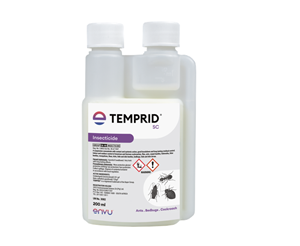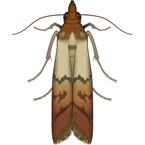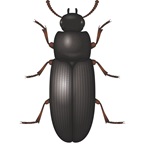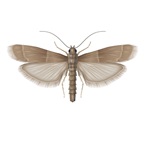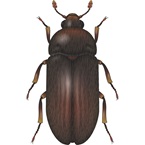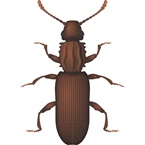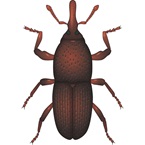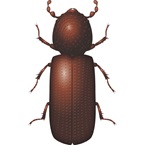Order: Coleoptera (‘sheath-wings’)
Family: Tenebrionidae
Lesser Mealworm:
5.5 - 6.7mm long
CHARACTERISTICS:
Forewings hard and leathery, meeting along mid-line of dorsal surface; hind-wings membranous, sometimes lacking; biting mouthparts; well-developed thorax; complete metamorphosis with egg, larval, pupal and adult stages. Usually 11-segmented antennae; front and middle tarsi are 5-segmented and hind tarsi 4-segmented.
SPECIES CHARACTERISTICS:
Lesser Mealworm Beetle / Litter Beetle (Darkling Beetle) (Alphitobius diaperinus)
Adults, 5.5 - 6.7 mm long; body, broadly oval, shiny dark-brown or black; elytra: uniformly coloured with moderately impressed striae; underside, dark redbrown; fore tibia strongly broadened at apex.
AREAS WHERE FOUND:
A cosmopolitan species thought to have originated in sub-Saharan Africa. In temperate areas they are typically found indoors although, being reasonably cold tolerant, they will survive in unheated buildings. The Lesser mealworm beetle is widely distributed in animal houses and especially poultry houses where the conditions reflect those of its tropical origin. Infestations are encountered in deep-pit and deep-litter poultry houses. They are associated with a variety of stored products. Infestations in animal houses may be introduced by way of contaminated feed. The insects live in the manure and litter of poultry houses and are often associated with the feed and water lines.
IMPORTANCE AS A PEST:
Damage to the structure of poultry houses. The larvae will tunnel earth floors rendering them uneven and difficult to clean. Significant structural damage can be caused as the larvae excavate tunnels in which to pupate. Wall plaster, which is in poor condition, may be damaged. In particular, polystyrene, fibreglass and other insulation materials can be damaged resulting in a significant increase in heating bills. Litter may be rendered so powdery that it must be replaced. Nuisance may be caused where beetles disperse to adjacent properties perhaps following the spreading of manure onto fields. The adults will fly if the temperature is sufficiently high and are attracted to artificial light. The beetles will consume housefly larvae although they are not generally regarded as a significant factor in fly control. They will also feed on the immature forms of Carcinops pumilio so reducing its effectiveness as a predator on houseflies. As a result of burrowing, they will aerate manure, causing it to dry and making it less attractive for houseflies to breed.
LIFE-CYCLE:
Females lay up to 400 eggs in manure, litter, cracks and crevices in buildings or commodities. The eggs are about 1mm long and sticky so are soon covered in debris and cease to be recognisable. They hatch within a week to give larvae, which are grey-brown in colour and exhibit a characteristic “tail horn.” The larvae are very active, avoid light and feed on litter, manure, spilt food and even dead or weak birds. There are approximately 5–11 larval stages and dark banding becomes more prominent with time. The larvae are fully-grown after 1–2 months and may be up to 15 mm long. Mature larvae seek suitable sites where they can pupate. These include the fabric of buildings which they may excavate causing significant damage. The pupae are light coloured and hatch in about a week, to give adults which can live beyond a year. Under optimal conditions the full life-cycle takes about five weeks.
CONTROL:
Assessment of infestations
A variety of trapping techniques are available for measuring stored product beetle infestations. These include pit fall traps, bait bags, insect probe traps and adhesive traps. The population may be measured by counting larvae on the fabric of buildings e.g. walls and posts. Samples of insulation materials can be placed around buildings and monitored for the entry holes of larvae seeking pupation sites.
- Hygiene/management
All sources of infestation should be removed and disposed of, taking care not to spread the infestation. Regular removal of manure and litter from poultry houses will control the beetle. Routine surveillance and regular cleaning are important but this can be difficult as the adults and larvae burrow making them inaccessible. Care should be taken to ensure that infested food is not taken into animal houses. Metal proofing strips provide physical barriers that can be built into structures to restrict migrating larvae reaching pupation sites in the fabric of buildings. There may be scope for employing insulation materials which are resilient to the larvae. Cooling premises to sub-zero temperatures for a number of days may help to control residual populations. - Insecticidal control:
Insecticides (see recommended products) can be applied to the fabric of infested premises concentrating on potential insect harbourages ideally after cleaning. It is difficult to control the insects in animal houses with insecticides because they are readily protected by the litter in poultry houses and as they burrow, whilst residues can be rendered ineffective by accumulations of manure and dust. Barrier treatments can be applied to prevent migrating larvae reaching pupation sites. Care should be taken not to kill beneficial insects e.g. Carcinops pumilio.
GLOSSARY OF TERMS:
Elytra: Hardened forewings of the beetle, Striae: Grooves along or across body.

